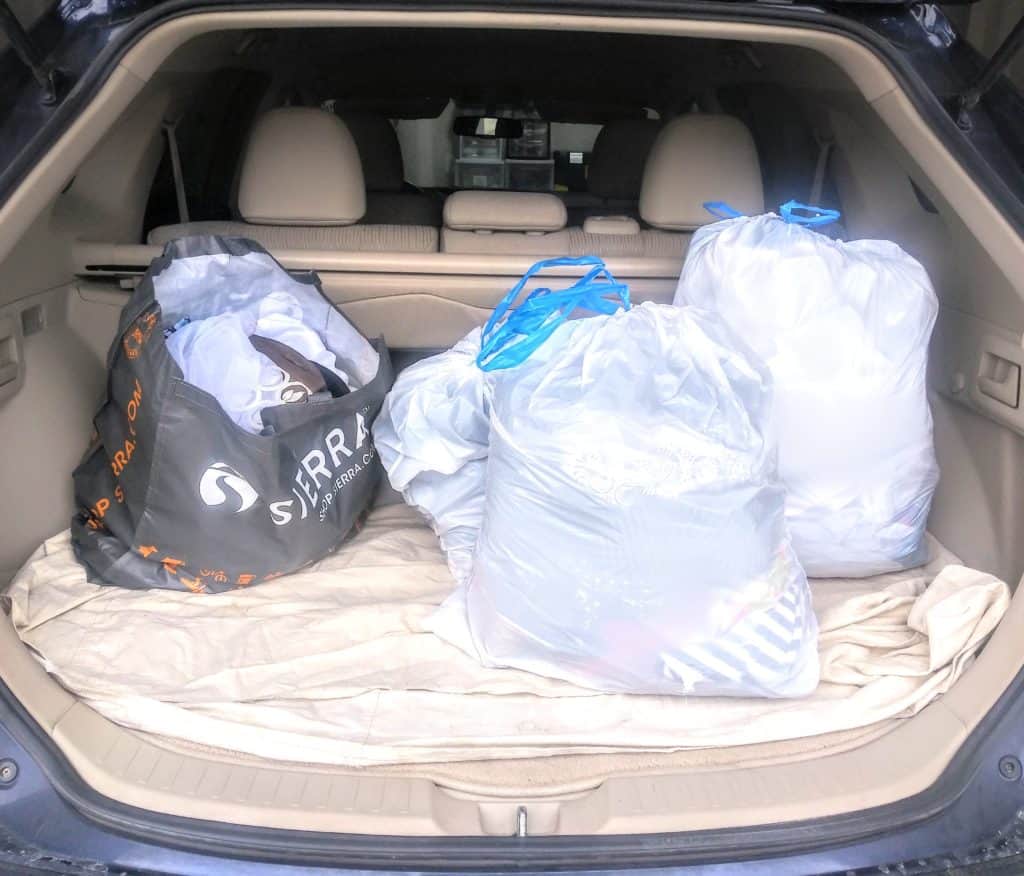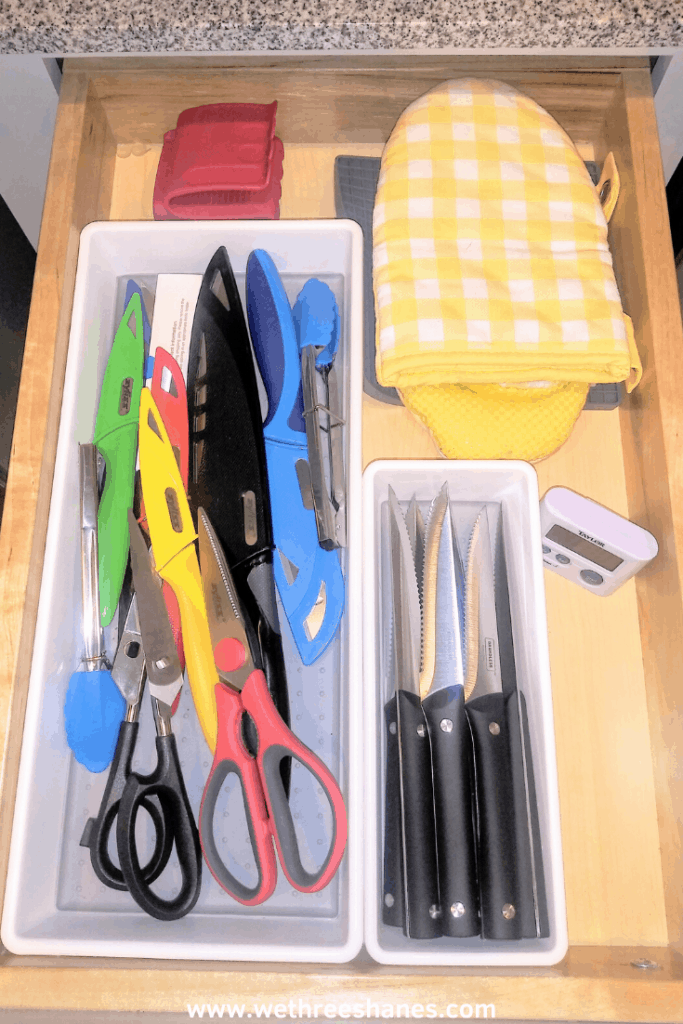The Last Decluttering Guide You Will Ever Need
Drowning in stuff? Learn this simple decluttering system to keep your home organized and clutter free! Spend less time cleaning & more time doing what you love!
(THIS POST PROBABLY CONTAINS AFFILIATE LINKS. OUR FULL DISCLOSURE POLICY IS LONG & BORING BUT, YOU CAN FIND IT HERE.)

Is Decluttering Worth the Effort?
Decluttering; you’ve thought about it (probably over and over again), but is it really worth the effort? Decluttering your home can be a huge task. The thought of it can be overwhelming.
Pulling items out of their hiding places can make a mess. Deciding what stays and what goes, can be difficult. Deciding where to take the stuff you plan on getting rid of is a big task.
If you think of all the decluttering steps and how much work they take to complete, it’s easy to feel defeated before you even start. You need to think about the why and not the how.
Does your home sometimes feel suffocating? Is there anxiety in your life because of mess or debt? Do you feel you have no time because your days are spent maintaining the stuff you own? Then, yes, it will be worth it!
Getting into a Decluttering Mindset
There are a few things to consider before you start decluttering.
- Don’t start with sentimental items. These are often the hardest things to declutter for most people. Save these items for the end once you have had a chance to see the benefits of decluttering and are more disciplined.
- It doesn’t have to happen all at once. Know your limits and schedule, and be realistic about your timeline.
- Get a quick win. Do a small project first. This is a visual way to quickly see the difference a clean space can make in your life and even your mood. Clean one junk drawer or the coffee table. Clear off the top of the desk. Set a quick goal and make it happen.
Tips for Decluttering Your Home
Here are the tips to get you well on your way to being a decluttering pro.
Tip 1 – Do one section at a time. Unless you are doing a 10 minute maintenance, don’t take on different areas of your house all at once. This will make it all too chaotic and overwhelming. Make a list of all the areas you want to declutter and take on one project at a time: a closet, dresser, office, etc.
Tip 2 – Ask yourself these three questions. If you look at an item and can’t quite make a quick decision about it then ask yourself the following three questions:
- Is this item useful/do I need it?
- Does it bring me real joy?
- Would I exchange the same amount of money to re-buy it today?
Tip 3 – You don’t just have to trash everything you declutter. Knowing someone else can benefit from your clutter can help you let go. Yes, some stuff will be trash, but you can also have a box for stuff you want to sell and donate.
Make sure if you do decide to sell something that it will bring in enough value to make up for the time and effort to sell it. If the item will only bring in $1.00, it is probably not worth the time it will take you to sell the item, unless you’re having a yard sale. Don’t make your time worth less than you would take for a regular job.
Kim loves to have a yard sale every couple of years. You can even get friends or neighbors involved if you don’t have a ton of stuff to sell. You can make a good amount of money with an organized yard sell. You can learn how to set up a garage sale without tables if you need a bit of help.
Tip 4 – Have a chosen place to take donations and do it quickly. Once you have a section done, collect the items you want to donate in a box or bag and take them to you car right away.
This way they are easy to drop off when you are already out and about running errands. Don’t let items you already decided to let go of, work their way back into your life.

Tip 5 – Don’t keep something just because you spent money on it. It’s hard to admit when we’ve made a mistake, but that doesn’t mean it has to stay in our house and haunt us forever.
If you just had to have that Instant Pot everyone was talking about, but now you just aren’t using it at all, it goes. If it is an item of value, this might be one of the things worth selling.
Don’t keep an item just to prove a point or because you feel bad it cost money. So, there was a mistake. Allow yourself to recover from it and move on.
Tip 6 – You don’t have to keep something because it was a gift. When you receive a gift, if you said thank you then your obligation is done. Period.
We all get gifts that just don’t fit us. Remember the saying, it’s the thought that counts? Well, it’s true.
If the person really cares for you, they wouldn’t want their gift to be a burden to your life. Thank the person, even thank the item if it makes you feel better. If the item isn’t useful or it doesn’t bringing you joy, then let it go.
Tip 7 – If you haven’t used something in a long time, it probably isn’t useful to you. When you ask yourself the three questions, make sure you are thinking about yourself when answering.
Yes, the jacket you hold in your hands is a useful item. If you haven’t worn it in 2 years because it doesn’t go with any of your clothes and you have other jackets…then it’s not useful to you. Let it go.
If it’s an item you find useful but don’t use it often then consider your ability to borrow the item from a friend. If you don’t have room to store that chocolate fountain you use once a year but you know a friend has one ask them if you can use it occasionally and then get rid of yours.
Tip 8 – Have a maybe box. If there are some items that are just pulling at your heart strings that you just aren’t sure about, a maybe box can be a useful tool.
Put the item in the box and put the box somewhere out of site, like the garage. After 6 months, if you didn’t miss what was in the box, it’s time to say goodbye.
Tip 9 – Pictures can help with sentimental items. Do you have large items that are taking up space, but you are having a hard time parting with them because of sentiment?
Take a picture of it. Then you can put it in a memory book or box in a much smaller form.
Getting creative with the sentimental items usually helps you appreciate them more. You can’t appreciate those t-shirts your saving in a box but you can enjoy a t-shirt quilt on a regular basis.
Wedding cards stuck in a box? Cut out the cute patterns & sayings to create a piece of art for your bedroom.
Think outside the box, literally. Because you can’t appreciate sentimental items that are tucked away.
Maintaining Your Space After Decluttering
I said this was the last guide you would need, right? So here is how you maintain once you have decluttered your space.
A Place For Everything
Everything you want to keep in your home needs to have a place. If an item was worth keeping it deserves a proper space in your home.
One memory box is okay, but everything else needs its own space. If an item doesn’t have a home, it’s really just an unmade decision. Make the decision for it to leave or find it a designated spot.
Certain items like small toys, sheets, towels, or throw blankets require somewhere to store them so they have a home. Some of my favorite storage solutions for these type of items are cute boxes and baskets.
Smaller items, like the tools in the kitchen require even smaller storage. I use small containers like these to keep my stuff neat and organized.

Get the family involved.
Once everything has a place, everyone needs to know that place! Mom should not be the only one maintaining the house but sometimes it’s frustrating for kids and partners when they aren’t sure where things go.
If they have to ask or guess where to put something then they’ll eventually just stop bothering. In fact, get kids and partners involved in the decluttering process, then you don’t have to worry about declutter anything that’s not yours without permission and they’ll be able to help you come up with spots for items that make sense to them.
Schedule time until it becomes a routine.
Even if it’s just 10 minutes and you have to set an alarm on your phone to remind you, set time aside every night to get your space back together. Get rid of any trash that accumulated during that day and put every item back in its designated home.
Ask the tough questions before bringing in new items.
We don’t want to fill the space we made with more stuff we don’t need. Remember to ask yourself questions before you purchase new items. Don’t be impulsive, it’s how we accumulate clutter.
- Do I really need this?
- Could I borrow this item from someone else?
- Would I rather have this item or the money in a savings account to go towards a goal I really want?
- Where will this items spot be in our home?
- If I waited for three days, would I drive back here to get this?

Remember Your Why
As you clean out the clutter, remember why you wanted to declutter your home in the first place. Keep your goals in your sights. Less clutter in your life can mean so many things:
- less to clean
- less to maintain
- Less to organize
- More time for the things we really love.
There can also be less stress and debt as we learn to control the desire to bring in more stuff. Do not fill your lives with items you don’t need and won’t make you happy. Instead, have an intentional life full of the things you really want.
